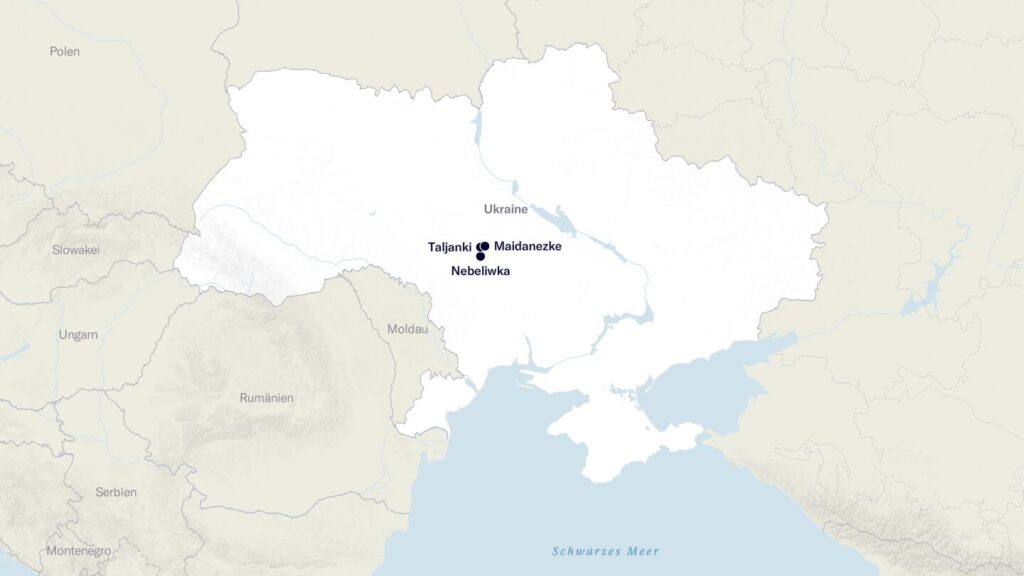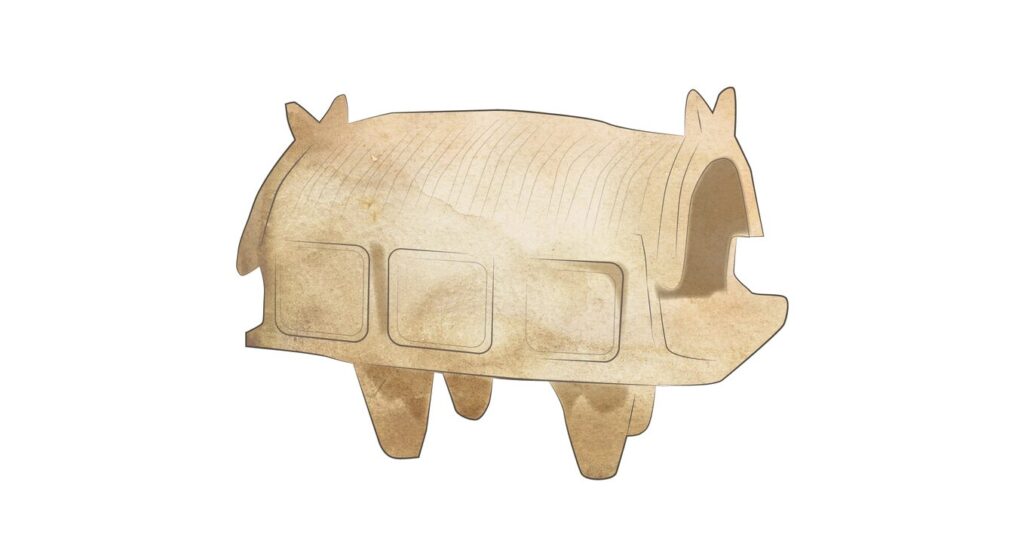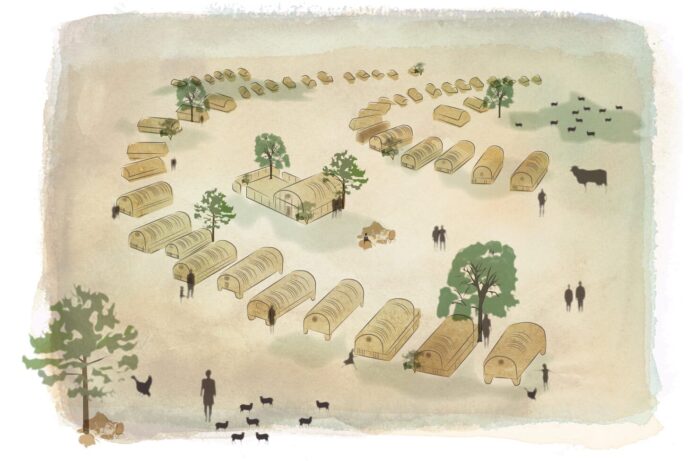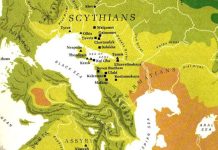6,000 years ago, people in the Eastern European forest-steppe built planned settlements with houses in concentric rings. Archaeologists argue about whether an egalitarian social order could have been behind this. A shadow and a few shards of clay, that’s all there is. There are just endless fields where corn, sunflowers or soy grow. Nothing indicates what lies in the ground here in Ukraine. The shadow can only be seen from the air, the shards only when walking across the field, and both only with trained eyes that know what they are looking for. Only when you look into the ground does it become clear that the shadow and the shards are not all that remains of what was once the largest city in the world. For decades, there was no doubt in archaeology that the first cities of humanity were built in Mesopotamia, in what is now Iraq, around 3,800 BC. It seemed certain that this was the only place where thousands of people lived together in a small space, fed on food produced in the hinterland, traded, and developed an administration. Now this apparent dogma is being seriously shaken: archaeologists are researching settlements that, as early as 4,000 BC, reached areas of up to 320 hectares – three times the size of the old town of Bern – and in which more than 10,000 people may have lived. They are not in Mesopotamia – but in Ukraine. And they show how different archaeologists can develop completely opposite narratives about the past from the same material.
When you talk to Johannes Müller about how these settlements were discovered, the term “five-year plans” comes up, and that shows that we are talking about the Soviet Union, so it was at least a few decades ago.
Müller is an archaeologist at the University of Kiel. Since 2011, he and a group of colleagues have been researching the giant settlements in Ukraine, especially one that is named after the modern name of the neighboring village of Maidanetske. 10 kilometers west of Maidanetske lies another giant settlement: Talianki. 30 kilometers south of Taljanki is the next one: Nebelivka. They are very similar; it is clear that they are part of the same phenomenon, the same social order. But as close as the settlements are to each other, the interpretations of their excavators are far apart.

In the mid-1960s, a military topographer named Konstantin Shishkin was looking over aerial photographs from Ukraine and discovered a shadow. If you look closely, you can still see the shadow today. It is created because the plants in the fields receive more or less nutrients and water in some places than in others. Archaeological remains are hidden underground in these places. Where there was once a ditch, the roots penetrate deeper into the earth and the plants grow higher. If the roots hit stones, the stems stay shorter.
These vegetation features were arranged in a way that made a natural geological cause unlikely: in concentric circles. Here, there were obviously man-made structures in the ground.
Aerial photographs only provide clues; they must then be verified on the ground. But it is unthinkable to completely excavate an area of several hundred hectares. So in 1971, Ukrainian scientists began a large-scale research campaign at some of these sites using a method that had only just been developed in archaeology: geomagnetism.
It is based on the measurement of very small changes in the Earth’s magnetic field caused by structures hidden in the ground and the iron particles they contain.
The method still requires manual work today, but the devices measure continuously, and so it is much faster than it was 50 years ago in Ukraine. Back then, there was only one magnetometer available, which had to be set up on a tripod at each measuring point. Only then could the measurement be triggered. Together with the previous creation of the grid, it is tedious, boring work. You can’t examine large areas this way. But that was the time of the Soviet Union. “Whole school classes were mobilized as part of the five-year plans,” says Müller, “and then it worked anyway.”
Within a short time, the size of a settlement that was only vaguely visible in the aerial photographs could be determined. If this had been attempted by excavation and ten houses uncovered per year, archaeologists estimated at the time that it would have taken more than 100 years to create a plan as detailed as that produced by geomagnetism.
What was known from this time and this region up to that point was mainly ceramics, vessels made of yellowish clay with decorations of geometric patterns and curved lines, the so-called Cucuteni-Trypillia ceramics. It was named in 1885 after two sites, Cucuteni in Romania and Trypillia in Ukraine, 40 kilometers south of Kyiv. Its distribution extends as far as the Republic of Moldova. The shards that were found during the excavations can also be assigned to this group.
The settlements in the vast area where this pottery was used are of all sizes. Opinions differ as to how many there are; at least 140 are said to be more than 10 hectares in size. However, giant settlements with more than 100 hectares only exist in Ukraine, on the northern edge of the Pontic Steppe. Archaeologists call them megasites, from the Greek word “mega” for something large and the English word “site”, which describes an archaeological site.
In the Soviet Union, they were a sensation, but in the West the spectacular findings met with little response. One reason was that no one believed that archaeologists in the socialist regime were capable of geomagnetically examining such large areas.
The other thing was that what the investigations revealed didn’t fit the picture at all. Settlements with several thousand houses, possibly cities, in concentric rings, from the so-called Copper Age – in Ukraine? That contradicted everything that was thought to be known about this period between the end of the Stone Age and the beginning of the Bronze Age: that people lived in small villages as farmers, at a time when they first began to experiment with metal, namely copper.
The collapse of the Soviet Union and the resulting opening of new research areas, better technology, and the questioning of old dogmas relating to concepts such as cities and civilization contributed to the fact that Western archaeologists such as Johannes Müller have been increasingly researching the Trypillia megasites for around 15 years. They have once again geomagnetically mapped a number of particularly large settlements. The new images have a much higher resolution than the old ones. The scientists have excavated some of the structures visible on them and taken soil samples.
If you look at the outline of the geomagnetic results and compare them with a modern city map, you can see immediately: a Trypillia megasite has nothing in common with a grown old town full of winding alleys. Seen from above, the settlements are round or oval. The houses are neatly lined up in concentric rings, interrupted at regular intervals by wide corridors. The middle is an apparently undeveloped square.
Such an arrangement does not come about by chance. Here the settlement was obviously planned, with plots of land marked out and gradually built on. These are the first planned cities of humanity, the smallest around 30 hectares in size – about the same size as the Sihlfeld cemetery in Zurich – the largest 3.2 square kilometers, more than the Principality of Monaco, almost as big as Central Park in New York.
The houses were made of wood and clay, comparable to today’s half-timbered houses. Whether they were one or two-storey is disputed, as is whether the gables were pointed or arched. In any case, they were all similar in many respects and were often similar in size, around 5 meters wide and 14 meters long. Müller even says: “The architecture is reminiscent of Lego, it was a modular system.”
The houses were burned down at some point, not by attackers in the context of a conflict, but in a regulated manner by their residents. We can only speculate about the motivation.
Perhaps there is a connection with the cult of the dead. Graves from the time of the megasites have not been found anywhere. “Individual graves are something with which the group of burying people represents their role to others. This reflection of social structures does not exist here,” says Müller. But, he immediately adds: “If there are no graves marked in an archaeologist-friendly way, that does not mean that a cult of the dead did not exist.”
Individual human bones are rarely found in the rubbish pits near the houses; these too, says Müller, “certainly have some kind of significance”. But regular burials are lacking; they only appear in the period after the megasites.
A number of buildings differ significantly from the residential buildings, if only in their size: one of these so-called megastructures in Nebelivka was 20 meters wide and 60 meters long, the largest building known to date in Europe at the time.
Nobody doubts that the megastructures had a special function. There is agreement that they are not large residential buildings because they lack storage vessels or the oven that was always present in the smaller houses. The giant buildings are in a prominent position, namely in the otherwise undeveloped, 100-meter-wide rings that lie between the rows of houses. It is quite possible that they are the key to the social order of the time. But archaeologists have completely different views on which function it fits into.
What, when, where – these are questions that the archaeological material readily answers. But there is one question that archaeologists must always answer by interpretation, and that is: why? Why did people in what is now Ukraine 6,000 years ago create planned settlements that were larger than anything that existed anywhere in Europe at the time? Why didn’t they just carry on living their lives in small village communities, as they had done before and as they would do again later? It took almost 3,000 years before there were settlements of comparable size again in what is now Ukraine, then Greek colonists founded cities on the Black Sea coast.
Up to this point, it was all about facts. Now, in a certain sense, it is about truth, and that is not really a suitable category in archaeology. But while it is often difficult to get more from archaeologists than “There are indications that it could have been this or that, but we don’t know for sure,” many of them seem surprisingly certain about Trypillia. They present their interpretation as the truth. The only problem is: they all have a different truth.
Some archaeologists, including Mikhailo Videiko from the University of Kyiv, hold a view that is in many respects rather traditional: it is taken for granted that as a society grows, so do social differences. Videiko sees signs of a hierarchical social order with a chief at the top in the large Trypillia settlements.
In addition, Videiko and like-minded colleagues follow a theory that the Lithuanian archaeologist Marija Gimbutas postulated between 1974 and 1991 in books of a “Goddess Trilogy”: In Europe, society was female-centered, matriarchal, and peaceful; people worshipped a “Great Goddess.” Patriarchy only became established with the immigration of the Indo-Europeans in the Bronze Age.
Many archaeologists reject this theory because there is too little evidence for it. Videiko bases his argument on the numerous terracotta figurines that were found in the megasites: like Gimbutas, he interprets them as female deities. The exposed buildings, the megastructures, are said to have been their sanctuaries.
The group around Johannes Müller in Kiel, however, sees no signs of sanctuaries and hierarchies. Müller interprets the buildings rather as communal meeting houses in which decisions were made together.
Since the houses are all very similar and there is no evidence of institutionalized social differences in the entire settlement, he assumes that the society is egalitarian. People moved from all over the area to the large settlements, which is why the surrounding areas were virtually depopulated. Müller and his colleagues support the “maximalist model”: They count how many houses there were, multiply this number by an estimate of five to ten residents per household and arrive at numbers “between 5,000 and 15,000,” as Müller says in the interview.
He assumes that all the houses that existed at the same time were also inhabited. Since these many thousands of people had to feed themselves and warm themselves by fires, this must have had an ecological impact on the surroundings of the settlements – and a negative one at that. However, based on soil analyses, Müller comes to the conclusion that the people in the settlement kept animals and used their excrement to fertilize the fields outside the settlement. There is no evidence that they ever overused the natural resources. The demand for wood was great, the forest was cleared and steppe took its place. However, the ecological carrying capacity was never exceeded and the effect was ultimately positive: “By improving the conditions for earthworms through deforestation, black soil is created,” says Müller.
The question of ecological impact is also the starting point of John Chapman, now emeritus, of the University of Durham and his colleague Bisserka Gaydarska. They experimentally built a replica of one of the houses in its original size and burned it down to determine how much wood was needed. There was so much that they argue that if all the houses had been in use at the same time and then burned down, a forest would have been needed for all the firewood. But this should be evident in the 6,000-year-old plant pollen from the soil samples. However, according to Gaydarska, there were no signs of deforestation or of intensive grain cultivation, which would be necessary to feed thousands of people.
While Müller and his colleagues conclude that the many thousands of people had found an almost magical way of not destroying the environment, Gaydarska draws a different conclusion: there couldn’t have been that many people, not at the same time. The settlement, she believes, was only used seasonally, as a pilgrimage center: people from the surrounding area came together here once a year to perform rituals and celebrate festivals. This also explains the large open space in the middle, which was never built on.
Johannes Müller calls it the “Woodstock theory,” and the way he says it makes it clear that he does not find it plausible. The same applies to the theory of a hierarchical society: Müller excavated together with Videiko, but their paths diverge when it comes to interpretation. Chapman and Gaydarska also think little of the hierarchy theory; they even openly admit that, due to differences in interpretation, they no longer feel able to write publications together with their Ukrainian colleagues.
And Regina Uhl says: “That’s not all there is to it yet.” Uhl works at the German Archaeological Institute as a consultant for prehistoric archaeology of the Black Sea region, and has been studying Trypillia since her studies. It is plausible that the megastructures were the meeting houses, she says. But she is skeptical about other aspects. The Kiel archaeologists based their assumptions about how many houses were inhabited at the same time on C14 data. But these are inaccurate for the beginning of the 4th millennium and could fluctuate by up to 150-200 years. “We can’t achieve the fine resolution,” says Uhl. “We can’t say whether all the houses were inhabited at the same time. But we can’t rule it out either.”
She also has concerns about an egalitarian society. “The data doesn’t support that.” She immediately adds: “The opposite isn’t true either. But this grassroots democracy is wishful thinking. The same houses don’t mean the same mindset, architecture isn’t the same social order.” Yes, the houses are all similar. “But if you do something regularly, like building houses, a certain standardization results.”
Uhl herself is excavating a settlement in the Republic of Moldova that is also laid out in concentric rings, but at 30 hectares is much smaller than the megasites in Ukraine. The houses and the ceramics are similar to those in Ukraine, but not the same. “It must have been an association of people who were in close contact, but it is unlikely that they had the same political or social organization everywhere.” She doubts that people really had so little negative influence on their environment. “I do think that people used the landscape in such a way that they had to move on at some point. Perhaps they – or some of the residents – moved from one settlement to the next because the carrying capacity was exhausted.”
She doesn’t believe that anyone has found the right interpretation yet. “That’s why we have to keep at it. We’re not finished with it yet.”
Uhl would also be cautious about saying that these are cities. She prefers to speak of “complex social structures”.
For a long time, Uruk in what is now Iraq was considered the first city in the world. In the 4th millennium BC, people lived here who did not have to farm themselves: city dwellers. They got their food from the surrounding hinterland, there was a ruling elite, monumental architecture, and an administrative system that included the development of writing. Archaeologists have long considered these to be essential features of a city.
But the Trypillia settlements have none of these characteristics. Johannes Müller, the archaeologist from the University of Kiel, says: “When I started researching the Trypillia sites in 2012, I never thought I would call them ‘cities’.” Now he does. “That is beyond question for me. A city requires a concept. And here, planning is evident from the very beginning.” And: “The decisive factor for me is not that they are huge settlements, but that you no longer know the people who live 1.5 kilometers away in the same settlement.”
Around 3,600 BC, the megasites disappeared again. Here, too, the big question is why. There is no evidence of conflict or violence, no invasion, no attacker from outside. It is reasonable to assume that the cause was home-made.
Johannes Müller from the University of Kiel also sees the end of the megasite phenomenon in connection with the egalitarian structure. “Around 4,100 BC, at the beginning of the megasites, the differences in house sizes disappear, and inequality obviously decreases,” says Müller. “When the settlements collapse, it increases again.”
It is likely that decisions were made by smaller and smaller groups over time, as shown by the disappearance of smaller meeting houses. But population numbers increased and other forms of communication were needed. “The reason for the collapse was what was not done,” says Müller. “Apparently, bureaucratization did not take hold as much as it did in Mesopotamia.” The people in the megasites did not invent writing, which developed independently in Mesopotamia, Egypt and China, for example, because there was a need for administration. Possibly – this aspect is still almost unexplored – they used so-called “tokens,” brands, as a counting system. But that was apparently not enough.
That is all Müller’s interpretation. Perhaps it was completely different. Each settlement lasted for about 200 years, and the whole phenomenon continued for about 500 years. That is much longer than most social orders that have developed since then, whether feudalism or industrial capitalism. Even if they are now just a shadow in a cornfield, the Trypillya megasites and their social order were a successful model for a long time. Now we just need to know which order it was. [Original Article in German]

Photo of Original Toy-Shrine >
The “Cradle of Civilizations” book published last year has more insights into the subject including other archaeological discoveries in Ukraine that the article above has missed.










